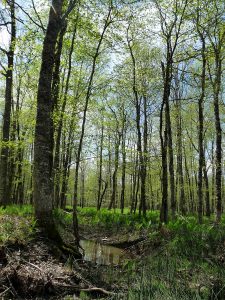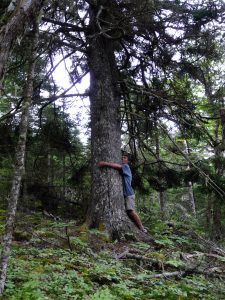
The biophilia hypothesis suggests that humans possess an innate tendency to seek connections with nature and other forms of life. Edward O. Wilson introduced and popularized the hypothesis in his book, Biophilia (1984). He defines biophilia as “the urge to affiliate with other forms of life”. The term “biophilia” means “love of life or living systems.
– Wikipedia
Also see posts under the category biophilia
Why is the world so beautiful? An Indigenous botanist on the spirit of life in everything
CBC Radio · Posted: Nov 27, 2020 “‘Western science is a powerful way of knowing, but it isn’t the only one says Robin Wall Kimmerer.”
We story the land
Documentary Video by Martha Stiegman and Sherry Pictou/Rippling Current media (viewed originally on Nova Scotia Advocate 2018/10/27) “The documentary follows seven paddlers from L’sɨtkuk (Bear River First Nation) as they travel inland following almost forgotten traditional Mi’kmaq canoe routes.” 26 min. Rippling Current Media 2016. “The Bear River reserve boundary cuts the people of L’sitkuk off from their ancestors’ hunting and fishing grounds. But there are old canoe routes that leave from the reserve, and cross the territory; and people here are working to reclaim them. WE STORY THE LAND follows seven paddlers as they travel through the land, to reconnect with a part of their history and a part of themselves.”
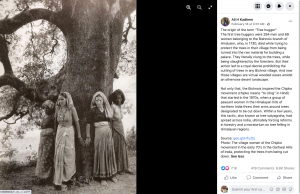
The origin of the term “Tree hugger” Facebook post by Ali H Kadhem on Feb 18, 2022
Diana Beresford-Kroeger bridges gap between science and spirituality
By Josiah Neufeld in BroadView . Nov 13, 2019 “The tree expert is working to protect the world’s vanishing forests…Orphaned at 12, Beresford-Kroeger grew up in rural Ireland, raised by her mother’s family to know the spirituality, language and law practised by the Celts since before English occupation. She learned to manage her emotions using a form of meditation, and to recognize the sacred and medicinal properties of plants and trees. But her scientific mind wasn’t content with esoteric explanations. She wanted to know how things worked.”
When Trees Have Standing
Linda Pannozzo on her blog, The Quaking Swamp Journal Feb 25. 2022. “More than forty years ago, law professor Christopher Stone advanced the view that natural objects and areas should have legal rights. “Should Trees Have Standing” Toward Legal Rights for Natural Objects,” became arguably one of the most provocative pieces of environmental law ever written…”
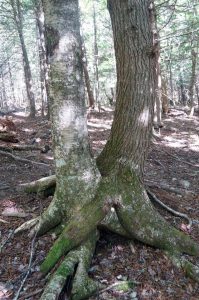 The Acadian Forest Love Affair
The Acadian Forest Love Affair
“The physical intimacy of yellow birch and hemlock often observed in old Acadian forest is more than a coincidence” Photo-essay by DGP posted on sandylakebedford.ca, Jan 25, 2018 Also available as a PDF on archive.org
Abrahams Lake Thoughts By A Stream (Video)
by Mark Brennan Jan 31, 2012. “A poem about self realisation, written in the Nova Scotia Wilderness with the sounds and sights of the surrounding area”
Nature recording-The Acadian Forest, Wild Earth Voices (Video)
by Mark Brennan Jan 8, 2013 “A short film on the soundscape release, Peskowesk, by Wild Earth Voices which takes you on a journey, in the Early Spring, through the sounds of the Acadian Forest of Nova Scotia.” Also see (listen to) Mark’s Wild Earth Voices soundscapes which include four albums in forest wilderness settings in Nova Scotia.
Treasures Of The Old Forest (Video)
Produced in 2005 Avalon & Meguma Natural History Films. “Precious as jewels, fleeting as snow-flakes, yet ancient as the forest itself, these are the wildflowers of the Acadian forest. The trillium, the spring beauty, the bloodroot and lady slipper, once as abundant as the songbirds – now driven to the far recesses of their range. A priceless inheritance many Maritimers may never see, truly, the Treasures of the Old Forest”.
Wild At Heart, Landscape Painter Greg Dickie (Video)
by Mark Brennan Sep 30, 2012 “Mark Brennan travels with Artist Greg Dickie of Windsor, Nova Scotia into the Tobeatic Wilderness Area of Nova Scotia in the fall of 2012.”
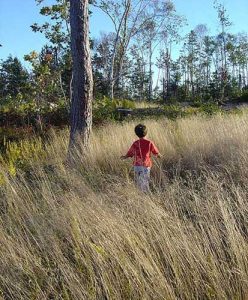 Child and Nature Alliance of Canada: Forest School Canada
Child and Nature Alliance of Canada: Forest School Canada
“Although they may have different names (Nature Kindergarten, Outdoor School, Waldkindergarten, Rain or Shine School, Bush School, etc.) the primary goal of the Forest School movement is to provide children with regular and repeated access to a natural space for child-directed, emergent and inquiry-based learning.” View Forest and Nature School in Canada: A Head, Heart, Hands Approach to Outdoor Learning for details about the approach and movement. A Forest School has now opened in Nova Scotia.
Retreats teach authentic leadership
Article by Allison Lawyer in the Chronicle Herald, Oct 6, 2017. “Slow down from fast complex world at Windhorse Farm” reads the byline which describes some of the history and philosophy of Windhorse Farm, near New Germany, Nova Scotia. ““The work I do is grounded in this forest,” says Drescher, sitting barefoot on a small wooden bench within the 160-acre forest that makes up most of Windhorse Farm. “I’ve learned and seen the powerful mirror the natural world provides. How natural systems work has a lot to teach us.”
 Words, rhythms and songs of the Forest Funeral at Province House, Nova Scotia, Oct 19, 2017
Words, rhythms and songs of the Forest Funeral at Province House, Nova Scotia, Oct 19, 2017
Audios of presentations at this event convey a lot of Biophilia, e.g. The Mi’kmaq Honour song honours all life…everything that has a spirit including the trees.
Experience an Old Growth Forest with Jenna Martin
TheMTRI, Published on Oct 24, 2016
The Happy Camper: Explore the Nova Scotia Wilderness in 360 VR
www.explore-mag.com
The right way to remember Rachel Carson
By Jill Lepore in The New Yorker, Mar 26, 2018 “Not until the end of her life did she write the work for which she is now known. Before then, she had always thought of herself as a poet of the sea…All creatures are made of the sea, as Carson liked to point out; “the great mother of life,” she called it. Even land mammals, with our lime-hardened skeletons and our salty blood, begin as fetuses that swim in the ocean of every womb.”
Thx to JB for this one.
The Tent Dwellers
“…if you are willing to get wet and stay wet – to get cold and stay cold – to be bruised, and scuffed, and bitten – to be hungry and thirsty, and to have your muscles strained and sore from unusual taxation: if you will welcome all these things, not once, but many times, for the sake of moments of pure triumph and that larger luxury which comes with the comfort of the camp and the conquest of the wilderness, then go!
The wilderness will welcome you, and teach you, and take you to its heart. And you will find your own soul there; and the discovery will be worth while!” – Albert Bigelow Paine in The Tent Dwellers. 1908.
View
– Book (Nimbus)
– KC Happy Camper: Nova Scotia Tent Dwellers – full film (32 min) (Posted Apr 15, 2018)
– Nova Scotia Canoe Tripping in 360 with the Happy Camper (4 min) “In this 360 video, the Happy Camper retraces the route described by Albert Paine in his 1908 book The Tent Dwellers. Traveling through Kejimkujik National Park to the historic Shelburne River in the Tobeatic, Kevin looks to discover how much has changed in 110 years and if you can still have a wilderness experience here.”
What Trees Talk About
CBC documentary nov 26, 2017 hosted by David Suzuki. Available only in Canada”Combining spectacular panoramic visuals with high-end CGI, this stunning nature documentary explores the secret life of trees, and how the world’s last great forest has the power to shape not only the lives of the plants and animals that live within it but our lives and life across the entire globe. New science is revealing that trees are far more dynamic than we ever realized, with a highly sociable nature and a penchant for generosity, allowing them to form vibrant communities.”
 The Possibility of Gaia
The Possibility of Gaia
Discussion at Kings College, Jan 31, 2019
“Dr. W. Ford Doolittle is one of the most well-known critics of the Gaia hypothesis. In 1981, he wrote an article for CoEvolution Quarterly titled “Is Nature Motherly?” in which he conjectured that there is nothing in the genome of organic life which could provide the feedback mechanisms the Gaia hypothesis proposes, and that, therefore, the Gaia hypothesis was an unscientific theory without any explanatory mechanism, in violation of the scientific method.” – Gaia hypothesis in Rationale Wiki
Darwinizing Gaia
WF Doolittle, J Theor Biol. 2017 Dec 7;434:11-19. doi: 10.1016/j.jtbi.2017.02.015. Epub 2017 Feb 22. “The Gaia hypothesis of James Lovelock was co-developed with and vigorously promoted by Lynn Margulis, but most mainstream Darwinists scorned and still do not accept the notion. They cannot imagine selection for global stability being realized at the level of the individuals or species that make up the biosphere. Here I suggest that we look at the biogeochemical cycles and other homeostatic processes that might confer stability – rather than the taxa (mostly microbial) that implement them – as the relevant units of selection. By thus focusing our attentions on the “song”, not the “singers”, a Darwinized Gaia might be developed. Our understanding of evolution by natural selection would however need to be stretched to accommodate differential persistence as well as differential reproduction.”
On Ecological Amnesia It’s why we forget the passenger pigeon, the reign of the buffalo. But not all of us suffer it.
By Wade Davis 8 Nov 2018 | The Narwhal, reproduced inthetyee.ca
Trees are at the heart of our country – we should learn their Indigenous names
Jakelin Troy in The Guardian Apr 1, 2019. Also view Mi’kmaq names for trees

“The thought of not being able to hear the ethereal flute-like song of a solitary hermit thrush at day’s end is most upsetting to me.” – VR in Yarmouth in the Chronicle Herald July 25, 2017
Embracing diverse worldviews to share planet Earth
F. Kohler et al., 2019. Essay in Conservation Biology 28 February 2019
The Bancroft Wood
YouTube Video by Cliff Seruntine posted May 5, 2019. “Bob Bancroft is a retired biologist who is widely known for his tireless work as an environmental advocate. What few people know about Bob, though, is that for the last forty-four years, he has been quietly working to restore the land around his home into a vibrant, self-sustaining forest. Facing challenges ranging from restoration of ruined soil to preparing the forest to adapt to impending climate changes, Bob’s lifetime labor of love is now a transitional forest that closely approximates a local, natural ecosystem, and as the forest matures, it is becoming a refuge for wildlife.
Ethiopia’s Church Forests
Saving Ethiopia’s “Church Forests
by T. DeLene Beeland on Berfois
Ethiopia’s ‘church forests’ are incredible oases of green
National Geographic Jan 18, 2019 BY ALEJANDRA BORUNDA PHOTOGRAPHS BY KIERAN DODD “When Alemayehu Wassie Eshete was a boy, he went to church each Sunday. He would make his way along the dry, dusty roads between the wheat fields in his home province in northern Ethiopia. At the end of the trip was the prize: a literal step into another world.”
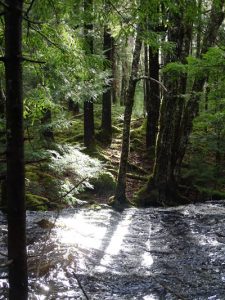 Should Trees Have Standing?: Law, Morality, and the Environment
Should Trees Have Standing?: Law, Morality, and the Environment
Book by Christopher D. Stone 1972 & 2010. From Amazon: Originally published in 1972, Should Trees Have Standing? was a rallying point for the then burgeoning environmental movement, launching a worldwide debate on the basic nature of legal rights that reached the U.S. Supreme Court. Now, in the 35th anniversary edition of this remarkably influential book, Christopher D. Stone updates his original thesis and explores the impact his ideas have had on the courts, the academy, and society as a whole. At the heart of the book is an eminently sensible, legally sound, and compelling argument that the environment should be granted legal rights. For the new edition, Stone explores a variety of recent cases and current events–and related topics such as climate change and protecting the oceans – providing a thoughtful survey of the past and an insightful glimpse at the future of the environmental movement. This enduring work continues to serve as the definitive statement as to why trees, oceans, animals, and the environment as a whole should be bestowed with legal rights, so that the voiceless elements in nature are protected for future generations.
“Finding the Mother Tree” – can it change the way we manage our forests in Nova Scotia? 9May2021?
Post on NSFN May 9, 2011 “A remarkable story was published this past week:
Finding The Mother Tree: Discovering The Wisdom Of The Forest by Suzanne Simard, 368 pages, Published:May 4, 2021, by Penguin Random House. Listed at $Can $34.95
It’s remarkable in many respects: as a scientific story that is effecting a “paradigm change” in how we think about forest ecosystems; as a very personal story that intersects with the author’s own health challenges; as a story that revealed/confirmed indigenous perspectives on forest communities; and very much more…
A day in the #Vanlife in Nova Scotia – Forest Cooking and Forest Bathing
DELORIS MACNEILL on YouTube Apr 21, 2020. “It’s been a heavy couple of days in NS. Sharing these magical moments in the forest with you as a small bit of offering during these hard times. I hope it inspires you to take in some nature and peace. Felt called to share, while at the same time enjoying the expansion these practices give me in being more connected, in expressive ways.
Shaman Sun; Shaman Shadow
Cliff Seruntine on YouTube Apr 2, 2019
 Meet the biologist who says trees have their own songs
Meet the biologist who says trees have their own songs
CBC Radio · Posted: Apr 18, 2017. “Wind, rain, wildlife, and how they interact with the different sizes and shapes of leaves and branches all make up what David George Haskell calls the “distinct voices” of trees. The Sewanee university professor spoke with As it Happens host Carol Off about his new book, The Songs of Trees.
Mango Groves of the North Woods
Youtube video by Cliff Seruntine. Apr 27, 2020 It’s about more than making tea!
True Facts about…
by zefrank1. Amusing but educational and fascinating nature videos
Biophilic Cities
Design Challenge: Biophilic Ci1es, Making Urban Environments More Diverse and Sustainable
A Half Earth project. Accessed Nov 12, 2020
The Serviceberry An Economy of Abundance
by Robin Wall Kimmerer in Emergence Magazine “As Robin Wall Kimmerer harvests serviceberries alongside the birds, she considers the ethic of reciprocity that lies at the heart of the gift economy. How, she asks, can we learn from Indigenous wisdom and ecological systems to reimagine currencies of exchange?”
How being still in nature can remind us of what it means to be human
Shalan Joudry · for CBC News Audio Essay
~The Woodpile~
By Otis A. Tomas on his use of trees t make stringed instruments. “I remember the Autumn day some years ago when I took this grand old maple tree down. Until that day, it had reigned for many years over the forest on the mountainside on the other side of the road, serene and unchallenged, its huge girth and towering canopy dominating all the other trees around. If ever the forest had a wise and experienced guardian, this was it. It had obviously stood there for what would have been many generations of my kind, watching the seasons come and go, growing tall and strong as the trees around it grew and died and grew again…”
Earth Adventures
A Favourite: Woodens River Adventure
…You have reached the top of the river. You must release the potion at the bridge if it is to work. But Dreeg has a troll guard living under the bridge. Put it to sleep:
Sneak across the bridge to the far side.
Find the enormous tree nearby on the other side. Touch the tree with the potion bottle to add some of its wisdom to the potion. It is one of the oldest Tamarack trees in the Province.
Now turn to the bridge and sprinkle some potion on the bridge.
Wave your wand as you repeat.
…The tree you touched is a very old tamarack tree (also called a larch or hackmatack), and is likely several hundred years old.
The Future of Nature: Conservation in the Anthropocene with Emma Marris
YouTube May 16, 2019 “(Visit: http://www.uctv.tv/) Emma Marris argues that there are different strategies to achieve the balance between nature, wilderness and the built environment. She challenges the idea of the pristine, pre-human state given that humans have altered their environment since pre-history. And, human-caused climate change is altering even the most remote places. She offers ideas on the future of nature and how we might think about it. Recorded on 04/24/2019. [5/2019] [Show ID: 34391]”

